If you’ve been following my previous series of guides on System Center Configuration Manager 2012 Beta 1 and Beta 2, then you’ll know where this is going, we are going to install System Center Configuration Manager 2012 Release Candidate from scratch and configure it, use it, test it, learn it.
Technet Recommended Reading:-
Getting Started with Configuration Manager 2012 – http://technet.micro…y/gg682144.aspx
What’s New in Configuration Manager – http://technet.micro…y/gg699359.aspx
Supported Configurations for Configuration Manager – http://technet.micro…y/gg682077.aspx
Planning for Site Systems in Configuration Manager – http://technet.micro…y/gg712282.aspx
Install Sites and Create a Hierarchy for Configuration Manager – http://technet.micro…y/gg712320.aspx
Technical Reference for Site Communications in Configuration Manager – http://technet.micro…y/gg712990.aspx
Migrating from Configuration Manager 2007 to Configuration Manager 2012 – http://technet.micro…y/gg682006.aspx
Frequently Asked Questions for Configuration Manager – http://technet.micro…y/gg682088.aspx
Site Types
Quote<p class=”blockquote”>
Configuration Manager 2012 introduces the central administration site and some changes to primary and secondary sites. The following tables summaries these sites and how they compare to sites in Configuration Manager 2007.
Central administration site
The central administration site coordinates intersite
data replication across the hierarchy by using Configuration Manager
database replication. It also enables the administration of
hierarchy-wide configurations for client agents, discovery, and other
operations. Use this site for all administration and reporting for the
hierarchy. Although this is the site at the top of the hierarchy in
Configuration Manager 2012, it has the following differences from a
central site in Configuration Manager 2007:
- Does not process client data.
- Does not accept client assignments.
- Does not support all site system roles.
- Participates in database replication
Primary site
Manages clients in well-connected networks.
Primary sites in Configuration Manager 2012 have the following differences from primary sites in Configuration Manager 2007:
- Additional primary sites allow the hierarchy to support more clients.
- Cannot be tiered below other primary sites.
- No longer used as a boundary for client agent settings or security.
- Participates in database replication.
Secondary site
Controls content distribution for clients in remote locations across links that have limited network bandwidth.
Secondary sites in Configuration Manager 2012 have the following differences from secondary sites in Configuration Manager 2007:
- SQL Server is required and SQL Server Express will be installed during site installation if required.
- A proxy management point and distribution point are automatically deployed during the site installation.
- Secondary sites can be tiered to support content distribution to remote locations.
- Participates in database replication.
Step 1. Create the Lab Environment
We are going to create a Standalone Primary Site
in our LAB (creating a CAS and then another Primary is a bit more work,
I may write up that process in the future), so let’s get started, and
to start off with I re-used/recycled my lab from Beta 2 by applying the
day 1 snapshots effectively giving me a blank activated AD and blank
SCCM 2012 server with the Operating System ready and activated.
This is a huge advantage of doing labs in a virtual environment.
The SCCM 2012 RC server for this lab has a C: partition (OS) and 150GB D: partition (DATA).
I chose to install Windows Server 2008 R2 standard as the server OS for
SCCM 2012 RC. Once done I joined it to my domain (SERVER2008R2),
verified DNS was working correctly via nslookup and was ready to begin the steps below.
Create AD users:
In addition I created some accounts in AD, namely:
* SMSadmin, a domain user,
* Testuser, a domain user,
* DomJoin, a domain user,(for joining to the domain)
* ReportsUser, a domain user for reporting services.
* ClientInstall, a domain user for installing the Vnext Client. This
user will be a local administrator on computers you want to install the
vNext Client.
* SCCMNAA, a domain user, (Network Access Account) used during OSD
Create Local Administrator accounts:
Perform the following on the SCCM 2012 server as Local Administrator
On the SCCM server I added the SCCM site server computer account (SCCM$) as a member of the Local Administrators Group. In addition, add the SMSadmin user to the Local Administrators group *you can add the ClientInstall account also).
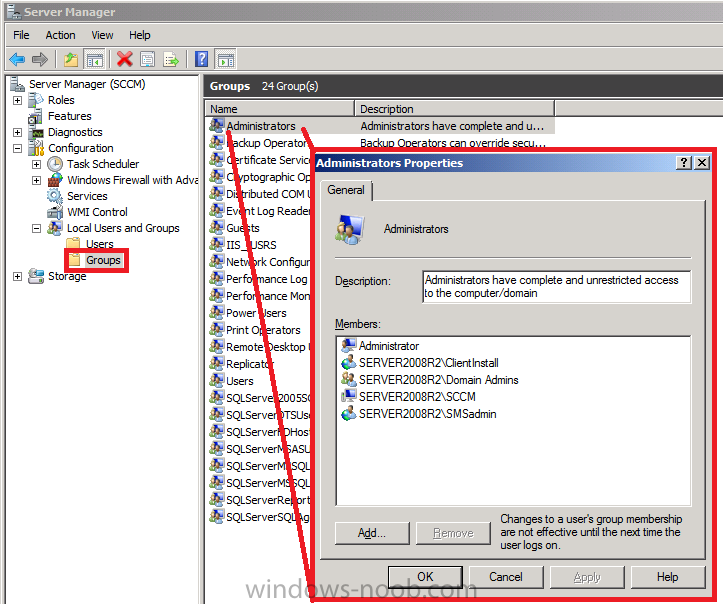
Step 2. Download SCCM 2012 Release Candidate
you can download it from Microsoft here.
System requirements
Supported Operating Systems: Windows Server 2003 R2 x64 editions, Windows Server 2008, Windows Server 2008 R2
Site System Requirements
- Site servers and site roles require 64-bit OS (distribution points are an exception)
Branch Distribution Points
- Branch
distribution points have been deprecated and replaced with standard
distribution points that can be hosted on Configuration Manager 2012
client operating system platforms, with the exception of Windows XP
Professional Service Pack 3 and Windows XP Tablet PC SP3 - Standard DPs can run on Windows Server 32-bit but will not support advanced functionality
Server Operating System Requirements
- Windows Server 2008 (64-bit) and Windows Server 2008 R2
- Distribution points can run on Windows Server 2003
Client Operating System Requirements
- Windows XP professional SP3 – x86 and Windows XP SP2 pro for 64 bit systems
- Windows Vista SP2 (x86,x64)
- Windows Server 2003 R2 SP2 (x86,x64)
- Windows Server 2008 (x86,x64)
- Windows Server 2008 R2 (x86,x64)
- Windows 7 (x86,x64)
Database Requirements
- SQL Server 2008 SP2 with CU 6
- SQL Server Express 2008 r2 WITH SP1 and CU 3 is supported only on secondary sites
- QL Reporting Services is ONLY reporting solution
For Supported Configurations information, visit http://technet.microsoft.com/en-us/library/gg682077.aspx.
Step 3. Create The System ManageMent Container
Note: Perform the following on the Active Directory Domain Controller as a Domain Administrator
Open ADSI Edit, click on Action, Connect To
and click Ok, Double Click on Default Naming Context and the DC= that
appears below it. Click on the + and scroll down to CN=System.
Right Click on CN=System and choose New, Object
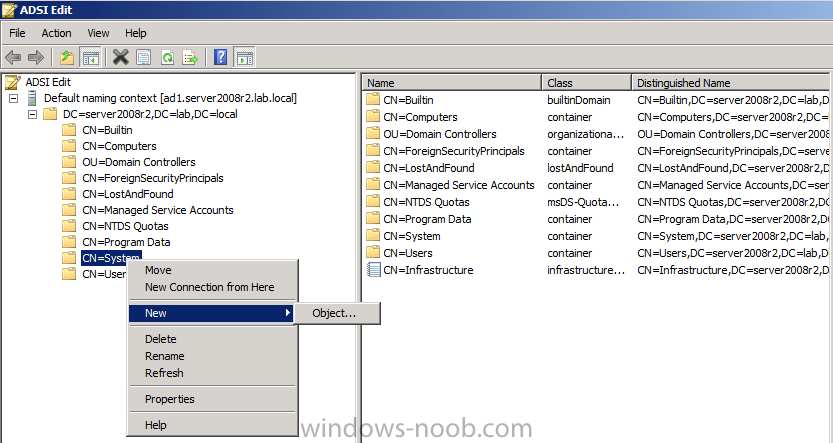
Choose Container from the options, click Next and enter System Management
as the value. Click Next and Finish. Press F5 to refresh ADSI Edit and
you should now see the new System Management Container. Close ADSI Edit.
Step 4. Delegate Permission to the System Management Container.
Note: Perform the following on the Active Directory Domain Controller as a Domain Administrator
Open Active Directory Users and Computers. Click on view, select Advanced Features.
Select the System Management Container, and right click it, choose All Tasks and Delegate Control.
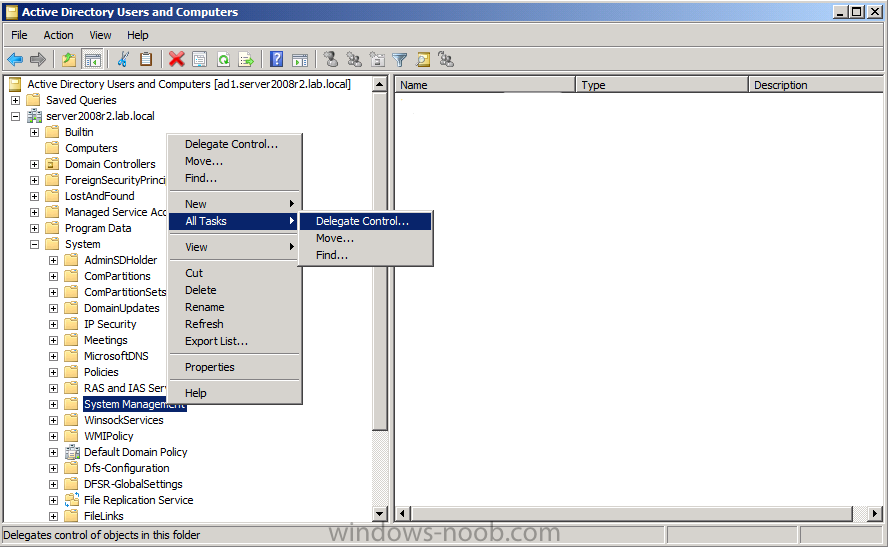
When the Welcome to Delegation of Control Wizard appears click next, then click Add. click on Object Types, select Computers. Type in your SCCM server name and click on Check Names, it should resolve.
Click Ok, then Next. Choose Create a Custom Task to Delegate, click next, make sure This folder, existing objects in this folder and creation of new objects in this folder is selected.
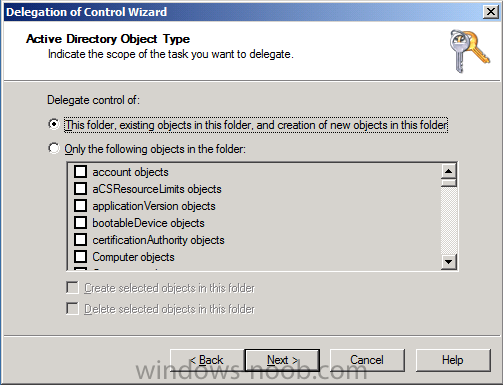
click next, select the 3 permissions General, Property-Specific and Creation-deletion of specific child objects are selected then place a check mark in FULL CONTROL, and click next then Finish.
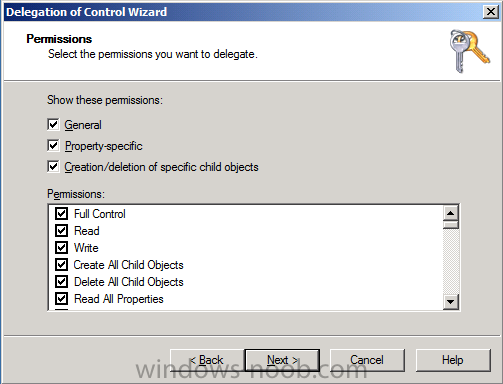
Failure to do the above will mean that the System Management
Container in AD will NOT POPULATE with SCCM site info needed by the
Clients and you will see many errors in your site status warning you of
same
Step 5. Extend the Active Directory schema for Configuration Manager
Note: Perform the following on the Active Directory Domain Controller as a Domain Administrator
Note:-
The Active Directory schema extensions for Configuration Manager 2012 are unchanged from those used by Configuration Manager 2007.
If you extended the schema for Configuration Manager 2007, you do not
need to extend the schema again for Configuration Manager 2012.
Perform the below on your Active Directory server, simply browse the
network to your sccm server \\sccm\d$ and locate the folder where you
uncompressed SCCM 2012 and find \SMSSetup\Bin\x64\Extadsch.exe, right
click and choose Run As Administrator.
A command prompt window will appear briefly as the schema is extended,
check in c:\ for a log file called ExtADSch.log it should look similar
to this
Quote
<10-27-2011 07:31:43> DS Root:CN=Schema,CN=Configuration,DC=server2008r2,DC=lab,DC=local
<10-27-2011 07:31:45> Defined attribute cn=MS-SMS-Site-Code.
<10-27-2011 07:31:45> Defined attribute cn=mS-SMS-Assignment-Site-Code.
<10-27-2011 07:31:45> Defined attribute cn=MS-SMS-Site-Boundaries.
<10-27-2011 07:31:45> Defined attribute cn=MS-SMS-Roaming-Boundaries.
<10-27-2011 07:31:45> Defined attribute cn=MS-SMS-Default-MP.
<10-27-2011 07:31:46> Defined attribute cn=mS-SMS-Device-Management-Point.
<10-27-2011 07:31:46> Defined attribute cn=MS-SMS-MP-Name.
<10-27-2011 07:31:46> Defined attribute cn=MS-SMS-MP-Address.
<10-27-2011 07:31:46> Defined attribute cn=mS-SMS-Health-State.
<10-27-2011 07:31:46> Defined attribute cn=mS-SMS-Source-Forest.
<10-27-2011 07:31:46> Defined attribute cn=MS-SMS-Ranged-IP-Low.
<10-27-2011 07:31:46> Defined attribute cn=MS-SMS-Ranged-IP-High.
<10-27-2011 07:31:46> Defined attribute cn=mS-SMS-Version.
<10-27-2011 07:31:46> Defined attribute cn=mS-SMS-Capabilities.
<10-27-2011 07:31:47> Defined class cn=MS-SMS-Management-Point.
<10-27-2011 07:31:48> Defined class cn=MS-SMS-Server-Locator-Point.
<10-27-2011 07:31:48> Defined class cn=MS-SMS-Site.
<10-27-2011 07:31:48> Defined class cn=MS-SMS-Roaming-Boundary-Range.
<10-27-2011 07:31:48> Successfully extended the Active Directory schema.
<10-27-2011 07:31:48> Please refer to the ConfigMgr documentation for instructions on the manual
<10-27-2011 07:31:48> configuration of access rights in active directory which may still
<10-27-2011 07:31:48> need to be performed. (Although the AD schema has now be extended,
<10-27-2011 07:31:48> AD must be configured to allow each ConfigMgr Site security rights to
<10-27-2011 07:31:48> publish in each of their domains.)
Step 6. Open TCP port 1433 and 4022 for SQL replication
Note: Perform the following on the Active Directory Domain Controller as a Domain Administrator
If you are setting up a hierarchy (CAS/Primary/etc) then on your AD
server do the following, start Group Policy Management tool and create a
new GPO,
Select Computer Configuration, Policies, Windows Settings, Windows
Firewall with Advanced Security and select Inbound Rules, choose New and
follow the wizard for opening up TCP port 1433 as per this guide on Technet. Once done, repeat the above for Port 4022.
Step 7. Install .NET 3.5.1 and WCF Activation
Perform the following on the SCCM 2012 server as SMSadmin
In Server Manager select Features, Add Features, Select .NET Framework 3.5.1, also select WCF Activation and when prompted answer Add Required Role Services click next and next again, and verify the following IIS components are installed in addition to the ones preselected by the wizard.
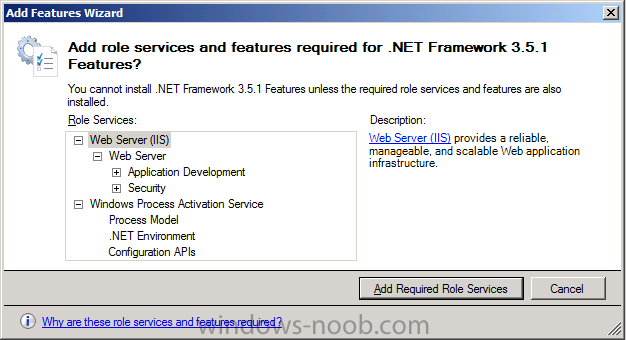
Common HTTP Features
Static Content
Default Document
Directory Browsing
HTTP Errors
HTTP Redirection
Application Development
ASP.NET
.NET Extensibility
ASP
ISAPI Extensions
ISAPI Filters
Health and Diagnostics
HTTP logging
Logging tools
Request Monitor
Tracing
Security
Basic Authentication
Windows Authentication
URL Authorization
Request Filtering
IP and Domain Restrictions
Performance
Static Content Compression
Management Tools
IIS Management Console
IIS Management Scripts and Tools
Management Service
IIS 6 Management Compatibilty
IIS 6 Metabase Compatibility
IIS 6 WMI Compatibility
IIS 6 Scripting Tools
IIS 6 Management Console
answer yes to any additional prompts, then Click Next and Install and close when done.
Step 8. Download and install .NET 4
Perform the following on the SCCM 2012 server as SMSadmin
Download .NET 4 from here (webinstall) or here (Standalone). Double click the file, After a while it will complete, Click Finish when done
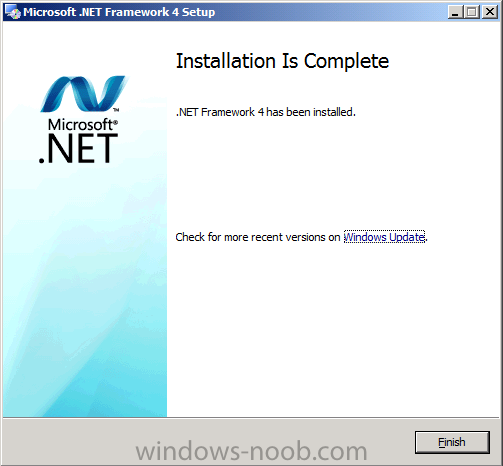
restart when prompted
Step 9. Add BITS and Remote Differential Compression
Perform the following on the SCCM 2012 server as SMSadmin
Finally, in Server Manager click on Add Features, place a selection mark in BITS and RDC.
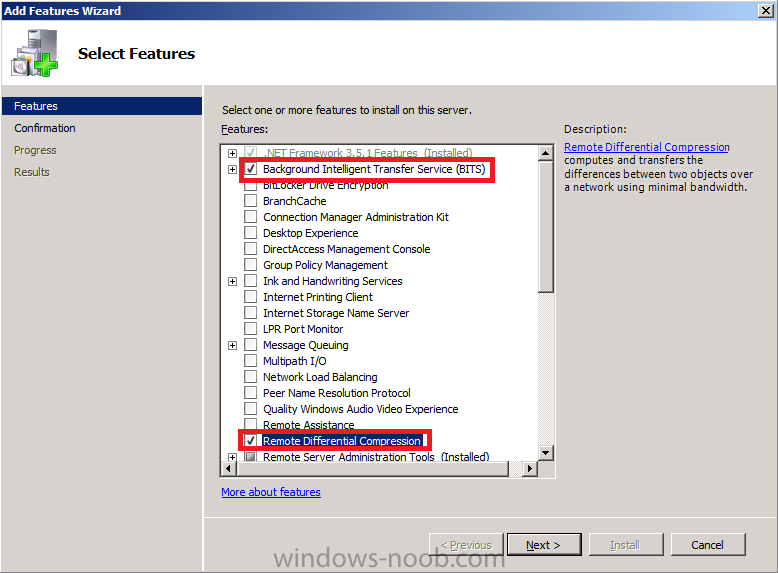
Step 10. Download Microsoft SQL Server 2008 SP2 CU6
Perform the following on the SCCM 2012 server as SMSadmin
Download SQL Server 2008 Standard (x86, x64) – DVD (English) from your provider (MSDN or Technet) the one I used was
File Name: en_sql_server_2008_standard_x86_x64_dvd_x14-89155.iso
Note: You can download the Trial version (180 days) from here.
While you are at it download SQL Server 2008 SP2 from here
File Name: SQLServer2008SP2-KB2285068-x64-ENU.exe
Next Download the CU6 from here
Step 11. Install SQL Server 2008
Perform the following on the SCCM 2012 server as SMSadmin
To Install SQL server follow this guide but please install SQL on D:\Program Files… and when running setup.exe right click and choose Run as Administrator.
After you install SQL Server 2008, you must install SP2 and finally install CU6.
So install it in this order:
SQL Server 2008 >> SQL Server 2008 SP2 >> SQL Server 2008 Cumulative Update 6
Step 12. Install Configuration Manager 2012 beta2.
Perform the following on the SCCM 2012 server as SMSadmin
TIP: you can open C:\ConfigMgrSetup.log with Configuration Manager Trace Tool available in the extracted media to and review the contents of the file, it will inform you of any issues during installation.
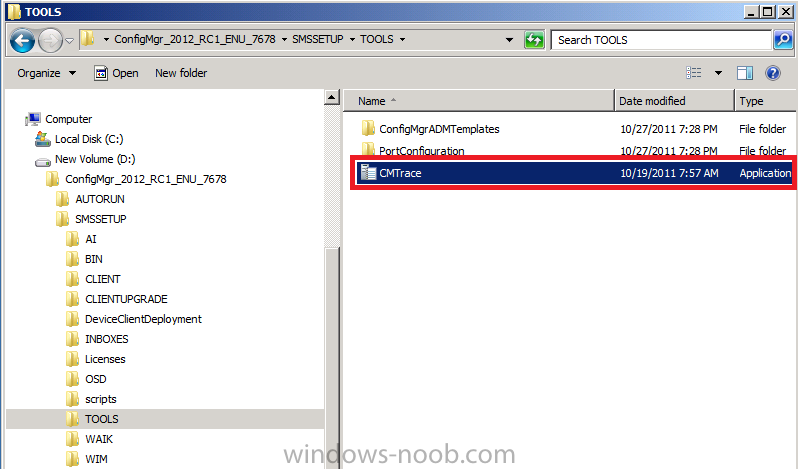
Uncompress the EXE by running it, then browse to where you uncompressed it and click on Splash.hta
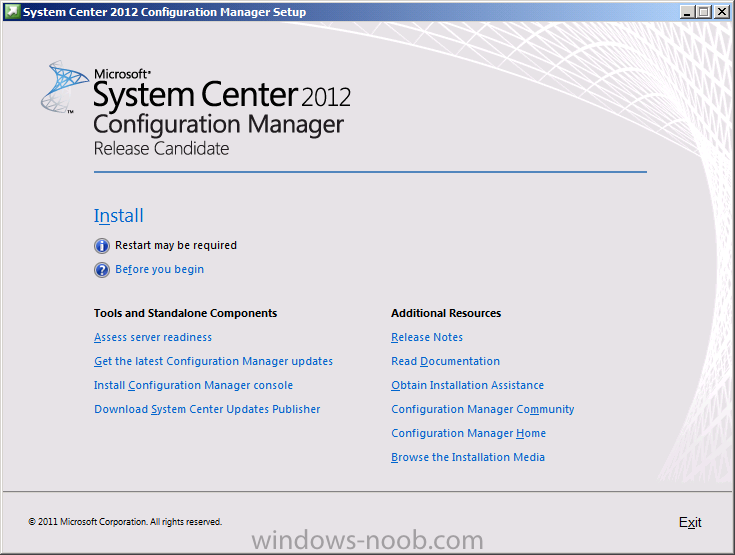
when the wizard appears, click on Install, click next at the warning and then select Install a Configuration Manager Primary Site
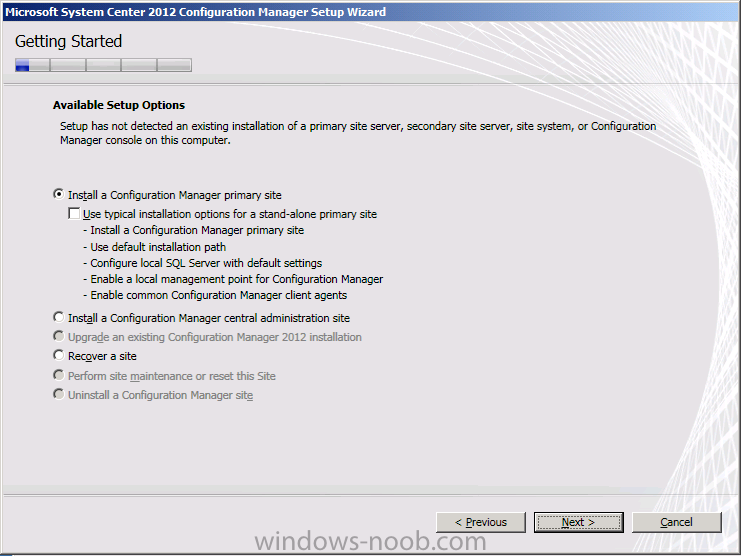
at the EULA click accept
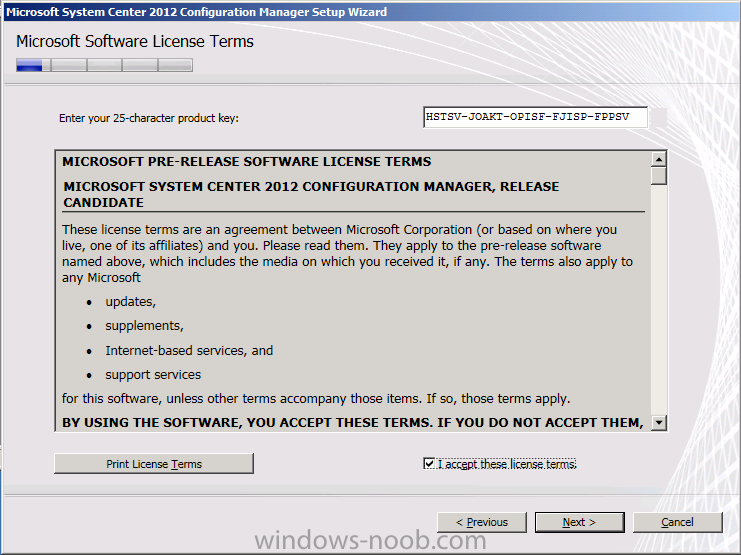
Create a folder on D:\ called RC_Updates and then specify the path to download the updates
Tip:
If you don’t have internet on your SCCM server then you can download the required updates on another computer by doing like so:-
- Open a command prompt with administrative permissions
- Navigate to .\Configuration Manager 2012 Install source\smssetup\bin\X64
- Run SetupDL.exe target dir (in my example SetupDL.exe D:\RC_Updates)
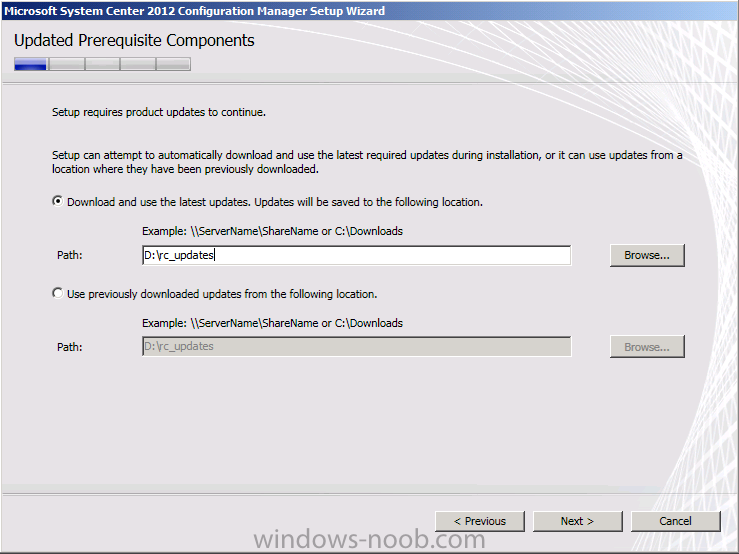
Click next at the Server Language screen
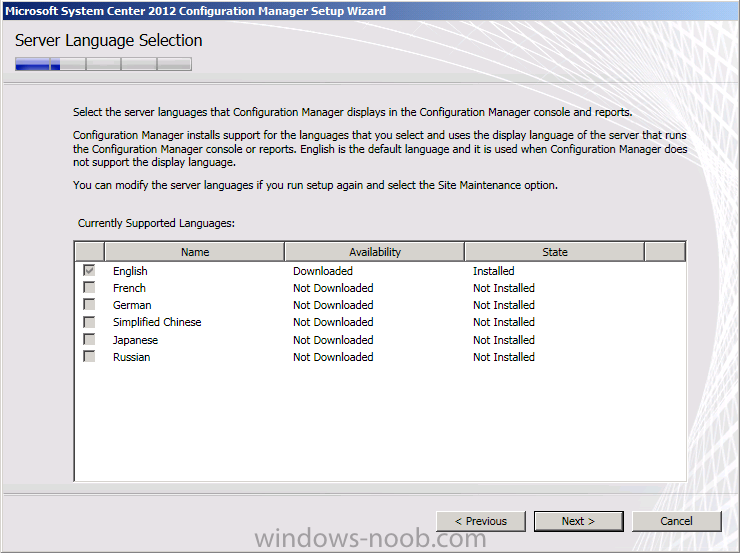
and at the Client Language Screen
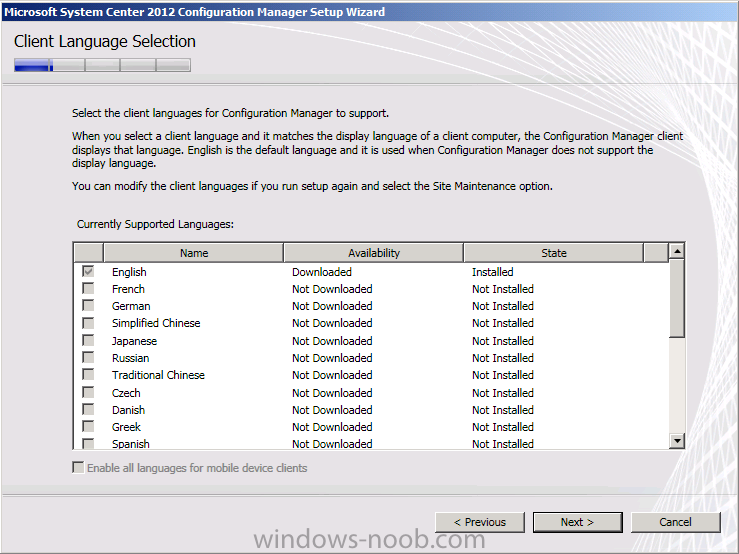
enter your Site and Installation Settings, install the site on D:\ as per below screenshot
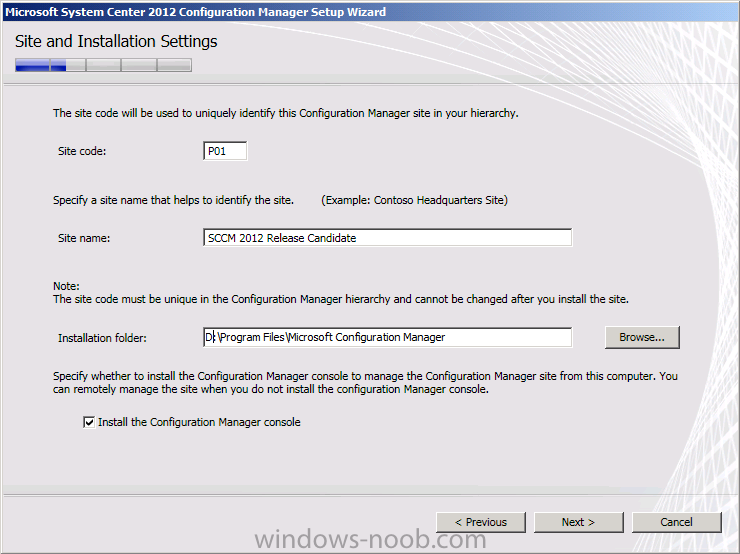
select Standalone as the site type
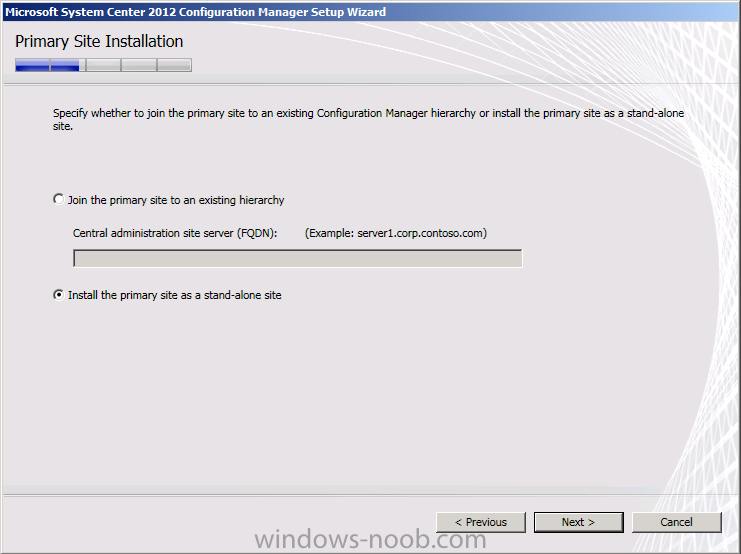
take note of the warning (ie: if will not be able to join it to an existing site heirarchy later)
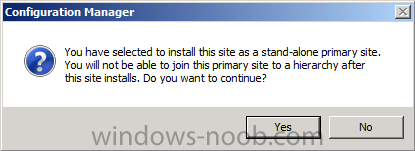
review the Database Information
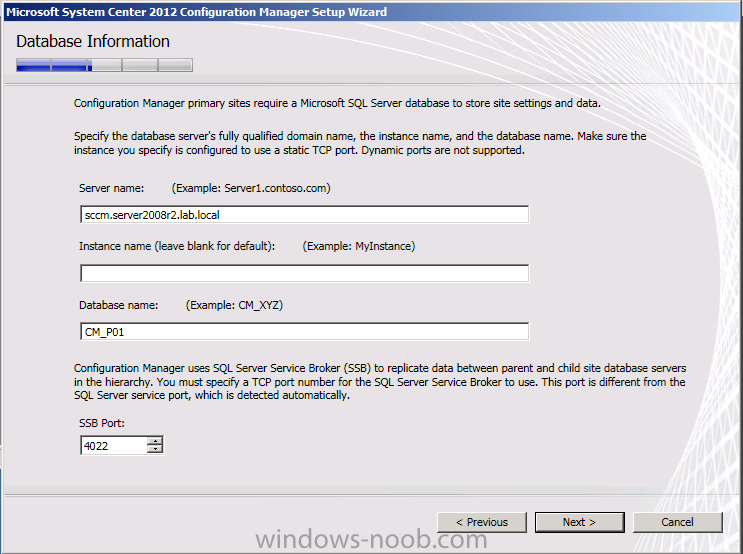
review the SMS provider settings
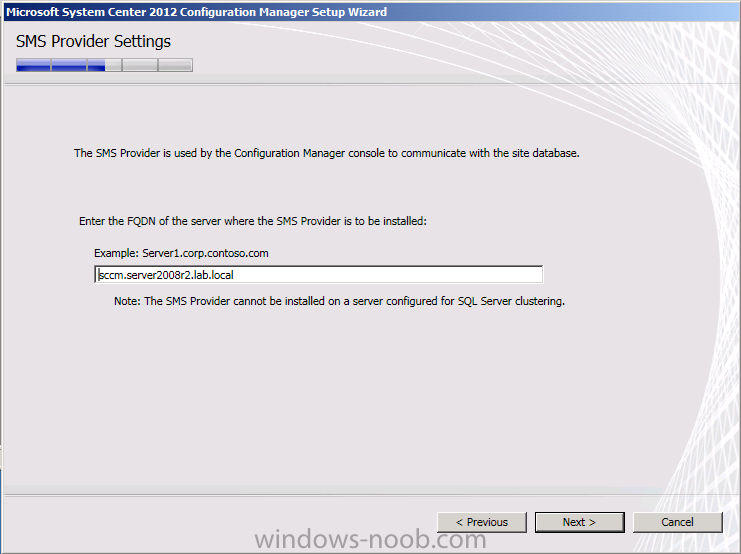
review the Client computer communication settings, select Configure the Communication method on each site system role
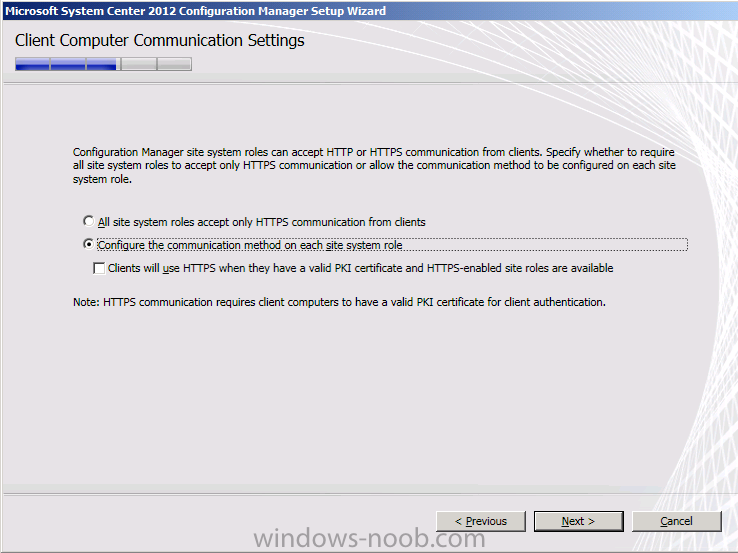
review the site system roles

click next at the CEIP screen then review the summary

take note of any warnings, if like mine (WSUS and SQL memory, we can fix them later, no problem)
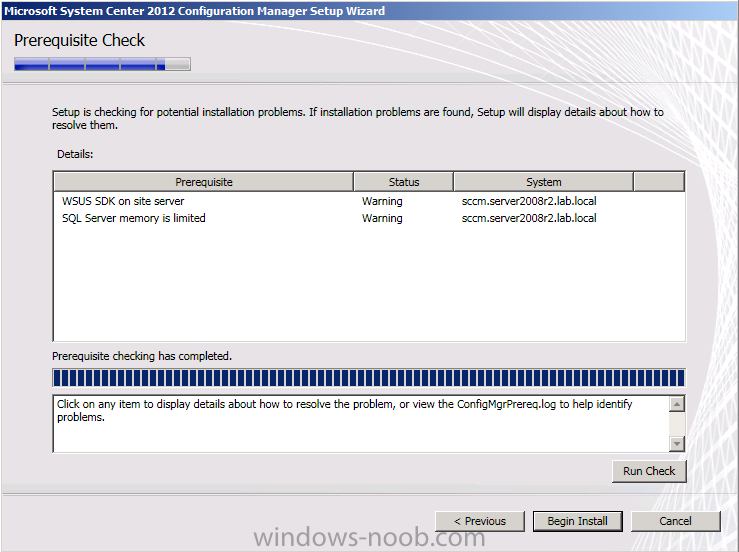
click on Begin Install
now is a good time to look at the C:\ConfigMgrSetup.log with CMtrace, watch it for errors

after a long install you should see the installer finish, click on Close
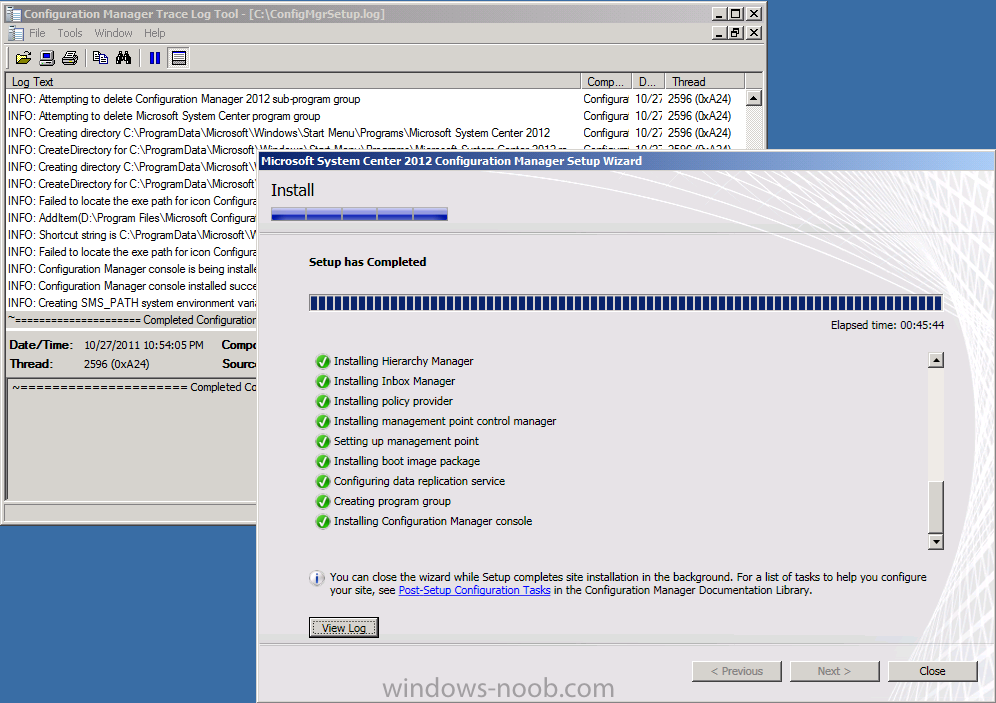
reboot the SCCM server and then login again as SMSadmin
start the Configmgr console
congratulations, you’ve installed System Center 2012 Configuration Manager Release Candidate
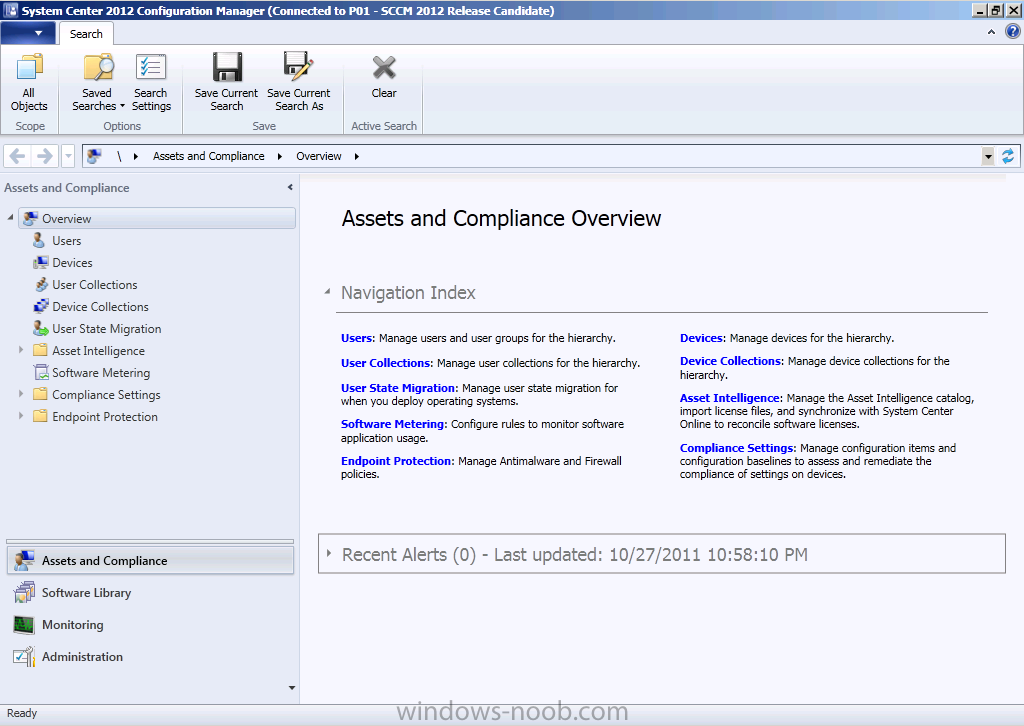
Note: This is the first in a series of articles about Configuring and using Configuration Manager 2012 – The original post is here on windows-noob.com, it’s likely that any changes (edits) to the post will only be done on windows-noob.com.


